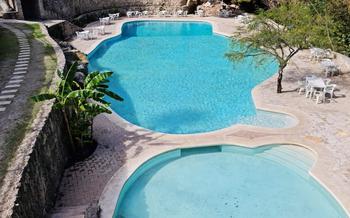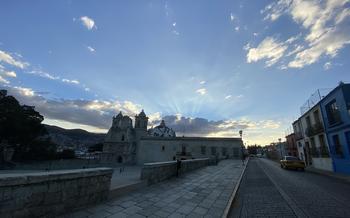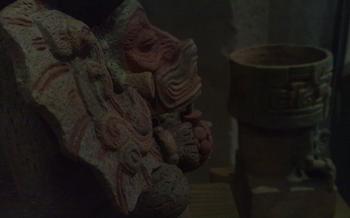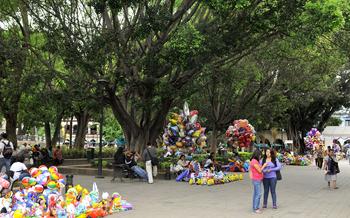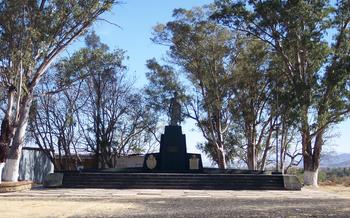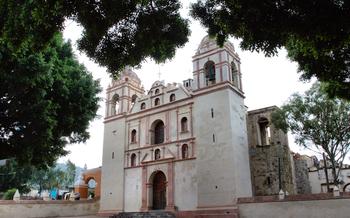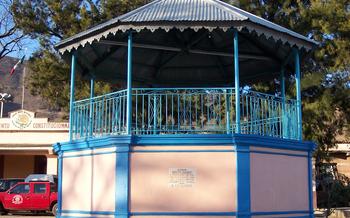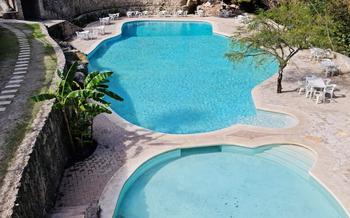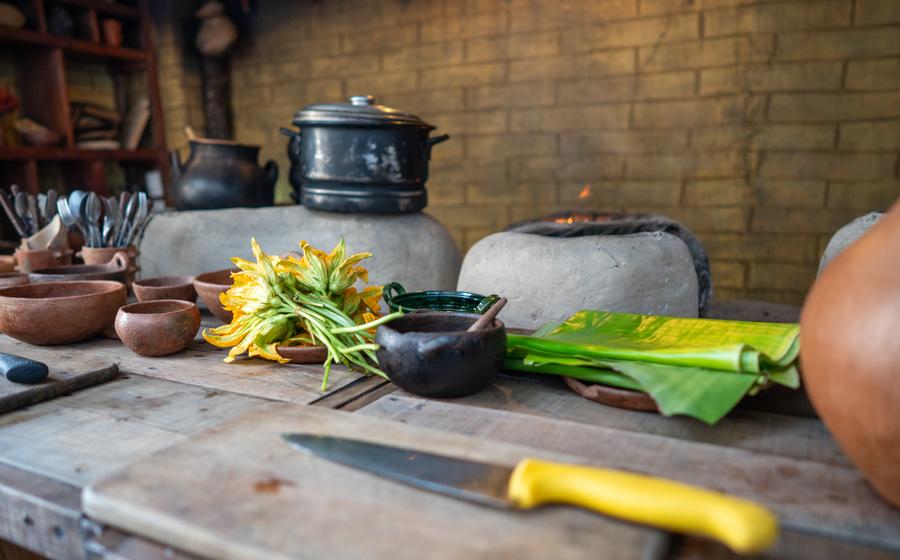
Capilla del Calvario
- Historical Significance
- Religious Importance
- Pilgrimage Site
- Panoramic Views
- Intricate Carvings
- Colorful Murals
- Traditional Ceremonies
- Guided Tours
- Accessibility
- Photography Tips
- Dress Code
- Nearby Attractions
Historical Significance
Nestled atop a hill overlooking the picturesque Oaxaca Valley, the Capilla del Calvario stands as a testament to the rich history and cultural heritage of the Zapotec people. Built in the 16th century, this magnificent chapel served as a place of worship for the Zapotecs, who have inhabited this region for centuries. Its unique architectural style, featuring a blend of Spanish colonial and indigenous elements, reflects the fusion of cultures that shaped the city of Oaxaca.
The chapel's hilltop location holds great significance, as it was once part of the ancient Zapotec city of Monte Albán. This ancient city, now a UNESCO World Heritage Site, was the political and religious center of the Zapotec civilization, making the Capilla del Calvario a spiritual successor to the sacred sites of the past. The chapel's construction marked a period of transition in the region, as the Zapotecs embraced Christianity while preserving their cultural identity.
Religious Importance
The Capilla del Calvario's religious significance as a place of worship for the Zapotec people cannot be overstated. A sacred site for centuries, the chapel has played a crucial role in the local Catholic community. During religious festivals and celebrations, it is a hub of activity.
The most notable of these festivals is the annual fiesta in honor of the chapel's patron saint. This grand event attracts pilgrims from far and wide, who come to pay homage and participate in the processions and offerings.
The chapel's interior is adorned with intricate carvings and paintings that depict biblical and historical scenes. These artworks hold deep symbolic meaning, contributing to the chapel's spiritual significance for the Zapotec people.
Pilgrims often come to the chapel to pray, light candles, and offer flowers. The chapel's serene atmosphere provides a sanctuary for reflection and spiritual growth, making it a cherished place for both Zapotec and Catholic devotees.
Pilgrimage Site
The Capilla del Calvario is not just a place of worship for the local community but also a significant pilgrimage site for both Zapotec and Catholic pilgrims. Every year, thousands of pilgrims flock to the chapel to pay homage to the patron saint, Señor de los Corazones, and to seek blessings and spiritual guidance.
The most important pilgrimage takes place during the annual fiesta in honor of Señor de los Corazones, held every year in September. During the fiesta, the chapel becomes a hub of activity, with pilgrims arriving from all over the region to participate in the processions, offer prayers, and receive blessings.
Pilgrims often bring offerings to the chapel, such as flowers, candles, and food, as a way of expressing their gratitude and devotion. They also participate in traditional rituals, such as lighting candles and praying at the altar, to seek divine intervention and protection.
For many pilgrims, the Capilla del Calvario represents a place of hope and healing. They believe that by visiting the chapel and praying to Señor de los Corazones, they will receive blessings and miracles in their lives. The chapel's spiritual significance makes it a powerful destination for pilgrims seeking comfort, guidance, and a deeper connection with their faith.
Panoramic Views
The Capilla del Calvario is not just a place of worship, but also a viewpoint that offers breathtaking panoramic views of the Oaxaca Valley and the Sierra Madre Mountains. From the chapel's hilltop location, visitors can enjoy a unique perspective on the surrounding landscape and the city of Oaxaca. The views from the chapel are particularly stunning at sunrise and sunset, when the sky is painted with vibrant colors that illuminate the valley and the mountains. Whether you are a nature lover, a photographer, or simply someone who appreciates beautiful scenery, the panoramic views from the Capilla del Calvario are not to be missed.
The chapel's location on the hilltop provides a unique vantage point from which to admire the beauty of the Oaxaca Valley. Visitors can see for miles in every direction, taking in the lush green fields, the winding rivers, and the distant mountains. The views are especially impresionantes on a clear day, when the air is crisp and the visibility is excellent.
The panoramic views from the Capilla del Calvario are a reminder of the natural beauty that surrounds the city of Oaxaca. The chapel is a place where visitors can come to appreciate the beauty of the landscape and to connect with the natural world.
Intricate Carvings
The Capilla del Calvario's facade and interior are adorned with intricate carvings and sculptures that showcase the skill and craftsmanship of Zapotec artisans. These carvings depict various religious figures, mythical creatures, and Zapotec motifs, each with its own unique symbolism and meaning. The main entrance to the chapel is flanked by two large columns, each adorned with finely carved figures of saints. Above the entrance, a frieze depicts the Last Supper, with Jesus and his disciples seated at a long table.
Inside the chapel, the walls are covered in intricate carvings that tell the story of the life of Jesus Christ. Scenes from his birth, crucifixion, and resurrection are depicted in vivid detail, with each figure carefully crafted to convey emotion and movement. The altar is adorned with a large, ornate altarpiece that features a carved figure of the Virgin Mary holding the infant Jesus. The pulpit is also intricately carved, with figures of angels and saints adorning its sides.
The carvings at the Capilla del Calvario are not just decorative elements; they serve to educate and inspire the faithful. They tell the story of salvation in a way that is both accessible and engaging, and they remind visitors of the importance of faith and devotion. The carvings also provide a glimpse into the rich cultural heritage of the Zapotec people and their deep connection to their Catholic faith.
Colorful Murals
The interior of the Capilla del Calvario is adorned with vibrant and colorful murals that depict biblical and historical scenes. These murals, painted by Zapotec artists, are not only aesthetically pleasing but also hold deep cultural and religious significance for the local community.
The murals cover a wide range of subjects, from the creation of the world to the life of Jesus Christ and the history of the Zapotec people. Each mural is meticulously crafted, with intricate details and vivid colors that bring the stories to life.
One of the most striking murals depicts the Last Supper, where Jesus is surrounded by his disciples at a table. The mural is painted in shades of blue and red, creating a sense of intimacy and solemnity. Another notable mural portrays the Virgin Mary holding the infant Jesus, surrounded by angels and saints. The Virgin Mary is depicted with a serene expression, her eyes cast down, radiating love and compassion.
These murals are more than just decorations; they serve as a visual representation of the Zapotec people's beliefs and traditions. They tell stories of faith, hope, and redemption, and they remind visitors of the rich cultural heritage of the Oaxaca region.
Traditional Ceremonies
The Capilla del Calvario is not only a place of worship but also a vibrant center for traditional Zapotec ceremonies and rituals. Throughout the year, the chapel hosts a variety of events that showcase the rich cultural heritage of the Zapotec people. One of the most important ceremonies is the annual fiesta in honor of the patron saint, which takes place every July. During the fiesta, the chapel is decorated with flowers and streamers, and the community gathers for a week of celebrations, including processions, traditional dances, and music performances.
Other traditional ceremonies that take place at the chapel include weddings, baptisms, and quinceañeras. These ceremonies are often conducted in the Zapotec language and incorporate traditional customs and rituals. Visitors to the chapel are welcome to attend these ceremonies and witness the vibrant expressions of Zapotec culture firsthand. By participating in these events, visitors can gain a deeper understanding of the living traditions of the Zapotec people and the important role that the Capilla del Calvario plays in preserving and promoting their cultural identity.
Guided Tours
To fully appreciate the Capilla del Calvario's rich history and cultural significance, consider embarking on a guided tour. Guided tours are available in English and Spanish and provide visitors with a deeper understanding of the chapel's architecture, artwork, and religious traditions. Knowledgeable guides share fascinating stories and anecdotes, bringing the chapel's history to life. Booking a guided tour in advance is recommended, especially during peak tourist season, to secure your spot and avoid disappointment. Group discounts and student discounts may be available, so be sure to inquire when booking. The cost of the guided tour is typically affordable and includes admission to the chapel.
Accessibility
The Capilla del Calvario is committed to ensuring that everyone has the opportunity to experience its beauty and cultural significance, regardless of their abilities. The chapel is fully accessible to visitors with disabilities, featuring ramps and other accessible features that make it easy to navigate the grounds and interior spaces. Visitors with wheelchairs or other mobility devices can easily move around the chapel and enjoy the panoramic views from the hilltop location. The staff at the chapel is also happy to provide assistance to visitors with disabilities, ensuring that they have a comfortable and enjoyable experience. The Capilla del Calvario's dedication to accessibility demonstrates its commitment to inclusivity and welcoming all visitors, regardless of their physical abilities.
Photography Tips
When visiting the Capilla del Calvario, don't forget your camera to capture the beauty of this sacred site. For stunning photographs, arrive early in the morning or late in the afternoon to take advantage of the soft, warm light. Position yourself at different angles to capture the chapel's intricate facade, colorful murals, and panoramic views. Remember to respect the chapel's sacred nature and avoid using flash photography or causing any disturbance during religious services or ceremonies. If you wish to take photographs inside the chapel, seek permission from the local authorities or a tour guide to ensure you follow the appropriate guidelines.
Dress Code
When visiting the Capilla del Calvario, visitors are expected to adhere to a respectful dress code. This is especially important during religious services or ceremonies, where modesty and decorum are highly valued. Casual attire is generally acceptable, but it should be neat, clean, and appropriate for a religious setting. Shorts, tank tops, and revealing clothing are discouraged. Visitors should also avoid wearing clothing with offensive or inappropriate slogans or images. By dressing respectfully, visitors can show their appreciation for the sacred nature of the chapel and contribute to a positive and respectful atmosphere for all.
Nearby Attractions
The Capilla del Calvario is not just a standalone landmark; it is part of a vibrant cultural landscape that offers a wealth of other attractions for visitors to explore. In the immediate vicinity of the chapel, you can find the Museo Comunitario del Calvario, which houses a collection of artifacts and exhibits that delve deeper into the history and culture of the Zapotec people. A short walk away is the Templo de Santo Domingo de Guzmán, a magnificent 16th-century church that is considered one of the finest examples of Baroque architecture in Mexico.
Venturing beyond the immediate vicinity, you can explore the bustling markets of Oaxaca, where you can haggle for traditional crafts, sample delicious local delicacies, and immerse yourself in the vibrant colors and sounds of Mexican culture. The city is also home to several museums, including the Museo de las Culturas de Oaxaca, which houses an extensive collection of pre-Hispanic artifacts, and the Museo de Arte Contemporáneo de Oaxaca, which showcases contemporary Mexican art.
For those who want to explore the natural beauty of the region, the Sierra Madre Mountains offer a stunning backdrop for hiking, mountain biking, and other outdoor activities. The Tule Tree, located just a short drive from Oaxaca, is a must-see for nature enthusiasts, as it is considered the oldest and widest tree in the world.
By combining a visit to the Capilla del Calvario with these other attractions, you can create a well-rounded travel experience that immerses you in the rich history, culture, and natural beauty of Oaxaca.
